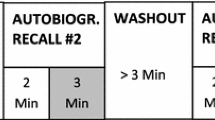Abstract
In the literature there is a wide number of experiments for induction of emotions using different types of stimuli. Apart from the samples with emotional content, neutral stimuli are typically used to set up a baseline state before or after the presentation of emotional stimuli. In the present study, the effect of these neutral stimuli and the duration necessary for reaching the baseline brain activity was assessed by means of a spectral analysis of electroencephalographic signals. Concretely, the brain activity at the beginning, middle and end of a neutral stimulus was compared with the activity at the end of the previously presented emotional stimulus. The results reported that 30 s of neutral stimulus successfully led to a baseline state after the elicitation of emotions with low arousal or low valence in all brain regions and for all frequency bands, whereas the double of time was necessary for the regulation of emotional states with high arousal or high valence levels. In addition, no statistical differences were found at the end of all neutral stimuli, corroborating the achievement of a common baseline regardless of the emotional stimulus previously shown.
Access this chapter
Tax calculation will be finalised at checkout
Purchases are for personal use only
Similar content being viewed by others
References
Alarcao, S.M., Fonseca, M.J.: Emotions recognition using EEG signals: a survey. IEEE Trans. Affect. Comput. 10(3), 374–393 (2017)
Coan, J.A., Allen, J.J.B.: Handbook of Emotion Elicitation and Assessment. Oxford University Press, Oxford (2007)
Cohen, M.X.: Analyzing neural time series data: Theory and practice. MIT press (2014)
Delorme, A., Makeig, S.: EEGLAB: an open source toolbox for analysis of single-trial EEG dynamics including independent component analysis. J. Neurosci. Methods 134(1), 9–21 (2004)
Egger, M., Ley, M., Hanke, S.: Emotion recognition from physiological signal analysis: a review. Electron. Notes Theor. Comput. Sci. 343, 35–55 (2019)
García-Martínez, B., Martinez-Rodrigo, A., Alcaraz, R., Fernández-Caballero, A.: A review on nonlinear methods using electroencephalographic recordings for emotion recognition. IEEE Trans. Affect. Comput. 12(3), 801–820 (2021)
Grecucci, A., De Pisapia, N., Kusalagnana Thero, D., Paladino, M.P., Venuti, P., Job, R.: Baseline and strategic effects behind mindful emotion regulation: Behavioral and physiological investigation. PLoS ONE 10(1), e0116541 (2015)
Han, J., Zhang, Z., Schuller, B.: Adversarial training in affective computing and sentiment analysis: recent advances and perspectives. IEEE Comput. Intell. Mag. 14(2), 68–81 (2019)
Ismail, W.W., Hanif, M., Mohamed, S., Hamzah, N., Rizman, Z.I.: Human emotion detection via brain waves study by using electroencephalogram (EEG). Int. J. Adv. Sci. Eng. Inf. Technol. 6(6), 1005–1011 (2016)
Jebelli, H., Hwang, S., Lee, S.: EEG signal-processing framework to obtain high-quality brain waves from an off-the-shelf wearable EEG device. J. Comput. Civ. Eng. 32(1), 04017070 (2018)
Katsigiannis, S., Ramzan, N.: DREAMER: a database for emotion recognition through EEG and ECG signals from wireless low-cost off-the-shelf devices. IEEE J. Biomed. Health Inform. 22(1), 98–107 (2018)
Kim, S.H., Hamann, S.: Neural correlates of positive and negative emotion regulation. J. Cogn. Neurosci. 19(5), 776–798 (2007)
Klem, G.H., Lüders, H.O., Jasper, H.H., Elger, C.: The ten-twenty electrode system of the International Federation. Electroencephalogr. Clin. Neurophysiol. 52, 3–6 (1999)
Koelstra, S., et al.: DEAP: a database for emotion analysis using physiological signals. IEEE Trans. Affect. Comput. 3(1), 18–31 (2012)
Liu, X., Li, T., Tang, C., Xu, T., Chen, P., Bezerianos, A., Wang, H.: Emotion recognition and dynamic functional connectivity analysis based on EEG. IEEE Access 7, 143293–143302 (2019)
Nahid, N., Rahman, A., Ahad, M.A.R.: Contactless human activity analysis across different modalities. In: Contactless Human Activity Analysis. Intelligent Systems Reference Library, vol. 200, pp. 237–270. Springer Nature (2021)
Poria, S., Cambria, E., Bajpai, R., Hussain, A.: A review of affective computing: from unimodal analysis to multimodal fusion. Inf. Fusion 37, 98–125 (2017)
Rahman, M.M., et al.: Recognition of human emotions using EEG signals: a review. Comput. Biol. Med. 136, 104696 (2021)
Russell, J.A.: A circumplex model of affect. J. Pers. Soc. Psychol. 39(6), 1161–1178 (1980)
Acknowledgements
Grants PID2020-115220RB-C21 and EQC2019-006063-P, funded by MCIN/AEI/ 10.13039/501100011033/ and “ERDF A way to make Europe”. Grant FPU16/03740 funded by MCIN/AEI/10.13039/501100011033/ and “ESF Investing in your future”. This work was partially supported by Biomedical Research Networking Centre in Mental Health (CIBERSAM) of the Instituto de Salud Carlos III.
Author information
Authors and Affiliations
Corresponding author
Editor information
Editors and Affiliations
Rights and permissions
Copyright information
© 2022 Springer Nature Switzerland AG
About this paper
Cite this paper
García-Martínez, B., Fernández-Caballero, A. (2022). Influence of Neutral Stimuli on Brain Activity Baseline in Emotional Experiments. In: Ferrández Vicente, J.M., Álvarez-Sánchez, J.R., de la Paz López, F., Adeli, H. (eds) Artificial Intelligence in Neuroscience: Affective Analysis and Health Applications. IWINAC 2022. Lecture Notes in Computer Science, vol 13258. Springer, Cham. https://doi.org/10.1007/978-3-031-06242-1_47
Download citation
DOI: https://doi.org/10.1007/978-3-031-06242-1_47
Published:
Publisher Name: Springer, Cham
Print ISBN: 978-3-031-06241-4
Online ISBN: 978-3-031-06242-1
eBook Packages: Computer ScienceComputer Science (R0)




